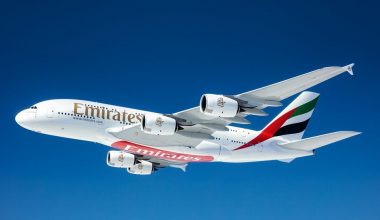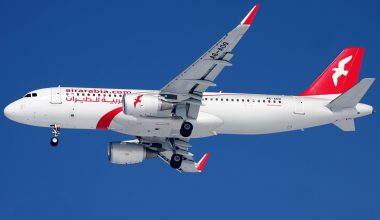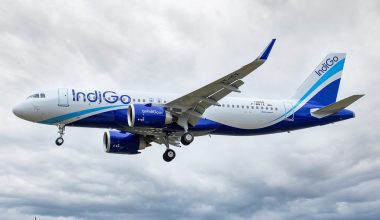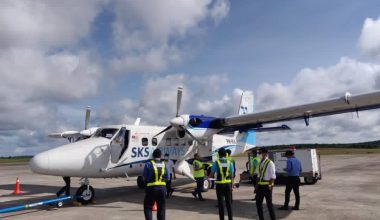Emirates is a state-owned flag carrier of the United Arab Emirates, based in Garhoud, Dubai. Founded on 25 March 1985, the Gulf carrier has now successfully recorded 37 years of globe-spanning operations. On top of being a mega Middle Eastern carrier, it is also the world’s fifth-largest airline by the number of countries served. Emirates boasts an industry-leading route network and serves hundreds of airport pairs across the globe. This guide covers a significant Emirates route map and profiles some of the carrier’s most lucrative routes.

Emirates route map
The mega Gulf carrier Emirates competes globally by serving an extensive network of over 150 destinations in 80+ countries across six continents. Emirates concentrates passenger traffic and flight operations from its hub in Dubai International Airport, the world’s busiest airport by international passenger traffic. As a highly-coordinated hub carrier, Emirates connects Dubai to more international destinations in the South and Southeast Asian region than any other Middle Eastern airline.

Country-wise, Emirates serves the largest number of airports in the United States (12), followed by India (9), the United Kingdom (8), Pakistan (5), and Australia (5).
Let’s take a step-by-step look at the Emirates route map in terms of the continents (regions) it serves.
Emirates route map within the Middle East

The Dubai-based Emirates currently operates flights to 14 Middle East destinations in 10 countries. Within the Middle East, Emirates operates the most airport pairs in Saudi (Dammam, Jeddah, Medina, and Riyadh). Likewise, it directly serves Baghdad Airport and Basra Airport in Iraq from Dubai. Besides, it provides nonstop air service to only one airport in Bahrain, Lebanon (Beirut), Kuwait, Iran (Tehran), Oman (Muscat), and Israel (Tel Aviv).
Emirates routes to Africa
Over the years, Emirates has cemented its presence in Africa and emerged as a leading carrier. Currently, the Emirates’ African network spans 22 destinations in 20 countries. Emirates route map in Africa includes covers key destinations including Abidjan, Abuja, Lagos, Accra, Addis Ababa, Algiers, Cairo, Cape Town, Durban, Johannesburg, Casablanca, Conakry, Dakar Blaise, Diagne, Dar Es Salaam, Entebbe, Harare, Khartoum, Luanda, Mauritius, Nairobi, and Tunis.
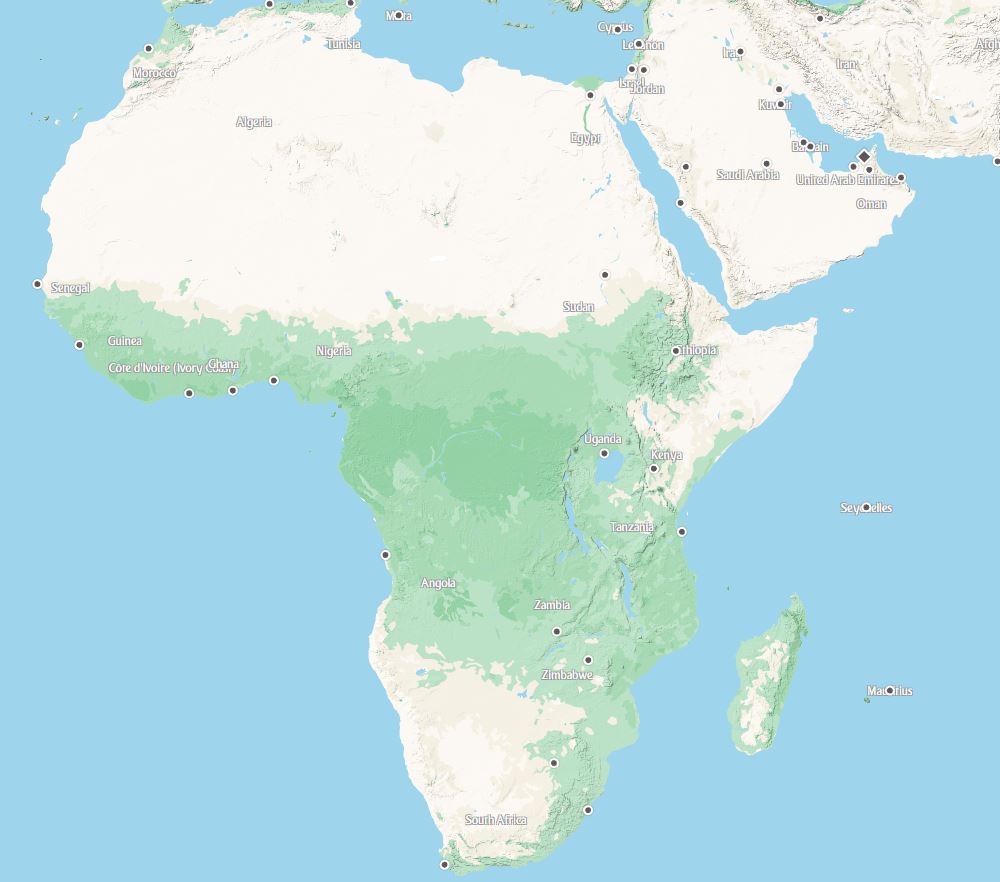
Emirates route to North America
The United States is a prolific market in Emirates’ global network as the carrier ferries high-yield tourists and business travelers from emerging markets in the Middle East and Asia Pacific. Emirates launched nonstop passenger flights to the US for the first time on the Dubai-New York JFK route in 2004. Since then, the airline has fortified its presence in the US by adding passenger services to 11 more destinations.

Emirates route map to the US covers cities of Houston, Los Angeles, San Francisco, Dallas, Seattle, Washington, Boston, Chicago, New York JFK, Newark, Orlando, and Miami. There are a total of 96 weekly flights on the Dubai-US route operated by the Dubai-based airline.
Apart from the US, the route map of Emirates Airlines in North America comprises Mexico and Canada. The airline operates flights to only one Mexican airport in Mexico City and a Canadian airport in Toronto. So, in total, the Emirates North American route map encompasses 14 different airports in 3 countries.
Emirates route map in the Asia-Pacific region
Emirates is a key airline operator in the Asia-Pacific region, as its route map hosts 47 robust destinations in 21 countries. Among them, the airline spreads its wings mostly to India, Australia, Pakistan, China, the Philippines, Vietnam, and Japan.
Within Asia, the state-owned carrier serves the largest number of airports in India, with flights to Ahmedabad, Bengaluru, Chennai, Delhi, Hyderabad, Kochi, Kolkata, Mumbai, and Thiruvananthapuram. Emirates is the largest international airline in India, with over 170 weekly flights between Dubai and nine cities across the country. The carrier’s long-haul flights cater to strong leisure and growing business travel demand in India.

The other key destination in Emirates’ flourishing Asia-Pacific route map is Australia. The UAE government-run airline has been operating flights to Australia for over 25 years since its inaugural service in 1996. Australia is the third-largest destination for Emirates’ A380 operations as the airline deploys its flagship A380 aircraft on flights to Melbourne, Sydney, and Brisbane. Emirates’ Airbus A380 seats a total of 516 passengers; 14 in First Class suites, 76 in lie-flat business class, and 426 in ergonomically designed Economy Class seats. Moreover, Emirates also operates passenger services to the Western Australian capital of Perth using Boeing 777-300ER.
Besides India, Pakistan is the second most-served Asian nation in terms of airport pairs on the Emirates route map. You can find several Emirates flights from Dubai to the Pakistani cities of Islamabad, Karachi, Lahore, Peshawar, and Sialkot.
Emirates’ route map to mainland China encompasses gateways Guangzhou, Shanghai, and Beijing. Similarly, its Philippine network includes flights from Cebu, Clark, and Manila. In Japan, Emirates offers passenger services to Osaka, Tokyo Haneda, and Tokyo Narita.
Furthermore, Emirates serves two airports each in New Zealand, Thailand, Indonesia, and Vietnam. Countries like Sri Lanka, Bangladesh, Afghanistan, Malaysia, Maldives, Korea, Seychelles, Singapore, and Myanmar receive Emirates’ services in only one respective city.
Emirates routes to Europe
In Europe, The UAE flagship airline operates eight airport pairs in the United Kingdom with flights from Birmingham, Edinburgh, Glasgow, London Gatwick, London Heathrow, London Stansted, Manchester, and Newcastle. Similarly, it serves four destinations, each in Italy (Bologna, Milan, Rome, and Venice) and Germany (Dusseldorf, Frankfurt, Hamburg, and Munich).

Altogether, there are 41 European destinations belonging to 23 countries on the Emirates route map. The Gulf giant serves three airports in France (Lyon, Nice, and Paris) and two each in Spain (Barcelona and Madrid), Switzerland (Geneva and Zurich), and Russia (Moscow and St. Petersburg). The carrier serves only one destination directly in the Netherlands, Greece, Belgium, Hungary, Denmark, Ireland, Turkey, Cyprus, Portugal, Malta, Norway, Czech Republic, Sweden, Austria, Poland, and Croatia.
Emirates route map featuring South American countries
The state-run Emirates has a minimal foothold in South America as compared to other continents. At present, the airline offers 11 weekly services to Brazil, serving the cities of Sao Paulo and Rio de Janeiro. It operates a daily flight on the Dubai-Sao Paulo route using flagship A380 aircraft. Meanwhile, the four-time weekly flights from Dubai to Rio de Janeiro further connect to Buenos Aires under the fifth-freedom route.
The state-of-the-art Airbus A380 offers nonstop connection to the Dubai-Sao Paulo segment on a daily basis. Likewise, Boeing 777-300ER performs the fifth-freedom route linking Dubai to Rio de Janeiro and onwards to the Argentine capital four times a week.
So, the Emirates’ South American route map currently covers two Brazilian and one Argentine gateway. The carrier used to serve Santiago de Chile prior to the COVID-19 pandemic, and it hasn’t resumed flights since then.
Most lucrative Emirates routes
One of the world’s largest carriers, Emirates generates attractive revenues in several routes. Some of the most lucrative Emirates routes are:
Dubai-London Heathrow

The corridor between Dubai and London Heathrow amasses lucrative revenue for Emirates Airlines. Emirates employs the Airbus A380 giant to perform 40 weekly flights between two busy airports. The behemoth A380 operates the Dubai-London Heathrow flight in 7 hours 40 minutes and has the capacity to accommodate 516 passengers.
Dubai-Riyadh
The Dubai-Riyadh city pair is the Emirates’ other most profitable service. The international route between Dubai and Riyadh receives around 280 weekly flights, 22 of which are operated by Emirates. Emirates uses A380 aircraft to cover 600 miles between two Arabian cities across the Persian Gulf. The mammoth jet completes the Riyadh-bound Emirates flight in less than two hours and ferries mainly business consultants.
Dubai-Mumbai
The air service operating from Mumbai to Dubai is another rewarding route for the UAE flag carrier. As the largest foreign carrier in India, Emirates operates five daily flights between Dubai International Airport and Chhatrapati Shivaji Maharaj International Airport. The much-loved 3-class configuration A380 transports passengers from Mumbai to Dubai and ferries them onward to western destinations. The Dubai-Mumbai corridor caters to both business and leisure travelers.
Dubai-Johannesburg
Emirates’ route connecting the UAE capital, i.e., Dubai, to the South African capital Johannesburg brings in millions of revenues every year. The carrier has a double daily A380 operation on the Dubai-Johannesburg route. The much-needed connectivity across South Africa’s gateway supports the country’s economic and tourism recovery and brings new travel opportunities and choices for Emirates customers. Effective 1 March 2023, Emirates will add a daily Boeing 777 service to and from Johannesburg to complement its twice-daily A380 operations.

Fleet of Emirates
The Dubai giant Emirates touts a well-balanced fleet composed of two wide-bodies aircraft families, the Airbus A380 and Boeing 777. The airline has a fleet size of over 250 aircraft encompassing 119 double-deck A380s, 10 Boeing 777-200LRs, and 124 Boeing 777-300ERs. To further bolster its wide-body fleet, the carrier has placed orders for 50 Airbus A350-900s, 115 Boeing 777Xs, and 30 Boeing 787-9 Dreamliners.
Emirates is the largest operator of the A380 ‘Giant of the Skies’ and one of the few carriers to operate an all-wide-body aircraft fleet. The A380 forms the backbone of Emirates’ long-haul, high-density route operations and raises the bar on premium experience for airline customers.

